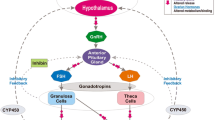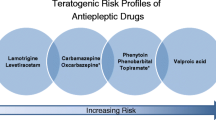Abstract
Recent studies have shown that certain pharmacological agents used by fathers before conception may increase the risk of adverse neonatal outcomes in offspring. However, little is known about the effect of paternal use of antiepileptic drugs (AEDs) on congenital anomalies in children. Based on Danish national registers, we conducted a cohort study of 733, 282 singletons born from 1997 to 2008, with follow-up throughout 2013. The children whose fathers used AEDs during the 3 months before conception were categorized as the exposed. Logistic regression model was used to examine association between paternal AEDs use before conception and the risk of congenital anomalies in offspring. Compared with unexposed children, the exposed had a 23% increased risk of congenital anomalies (odds ratios (OR) 1.23, 95% confidence interval [CI] 1.10–1.37) after adjusting for potential confounders. When extending the exposure window to 1 year before conception to the end of pregnancy, except for those using AEDs during 3 months before conception (the susceptible period of exposure), the increased risks were also observed in children whose fathers were former users (i.e., those using AEDs only from 1 year to 3 months before conception) (OR 1.29, 95%CI 1.03–1.61) and later users (i.e., those using AEDs only during pregnancy) (OR 1.35, 95%CI 1.12–1.65). This study suggested that the mildly increased risk of congenital anomalies in the offspring associated with paternal AEDs use before conception may be attributable to the underlying indications related to AEDs use.
Similar content being viewed by others
References
Fiest KM, Sauro KM, Wiebe S, Patten SB, Kwon C-S, Dykeman J, et al. Prevalence and incidence of epilepsy. A systematic review and meta-analysis of international studies. Neurology. 2017;88(3):296–303.
Janz D. Are antiepileptic drugs harmful when given during pregnancy? Ger Med Mon. 1964;9:20–2.
Meadow S. Anticonvulsant drugs and congenital abnormalities. The Lancet. 1968;292(7581):1296.
Meador K, Reynolds MW, Crean S, Fahrbach K, Probst C. Pregnancy outcomes in women with epilepsy: a systematic review and meta-analysis of published pregnancy registries and cohorts. Epilepsy Res. 2008;81(1):1–13.
Veroniki AA, Cogo E, Rios P, Straus SE, Finkelstein Y, Kealey R, et al. Comparative safety of anti-epileptic drugs during pregnancy: a systematic review and network meta-analysis of congenital malformations and prenatal outcomes. BMC Med. 2017;15(1):95.
Hauser WA, Kurland LT. The epidemiology of epilepsy in Rochester, Minnesota, 1935 through 1967. Epilepsia. 1975;16(1):1–66.
Engeland A, Bramness JG, Daltveit AK, Rønning M, Skurtveit S, Furu K. Prescription drug use among fathers and mothers before and during pregnancy. A population-based cohort study of 106 000 pregnancies in Norway 2004–2006. Br J Clin Pharmacol. 2008;65(5):653–60.
Schirm E, Pedersen L, Tobi H, Nielsen GL, Sørensen HT, de van-den Jong Berg L. Drug use among fathers around time of conception: two register based surveys from Denmark and The Netherlands. Pharmacoepidemiol Drug Saf. 2004;13(9):609–13.
Abbasi J. The paternal epigenome makes its mark. JAMA. 2017;317(20):2049–51.
Day J, Savani S, Krempley BD, Nguyen M, Kitlinska JB. Influence of paternal preconception exposures on their offspring: through epigenetics to phenotype. Am J Stem Cells. 2016;5(1):11.
Su XJ, Yuan W, Huang GY, Olsen J, Li J. Paternal age and offspring congenital heart defects: a national cohort study. PLoS ONE. 2015;10(3):e0121030.
Cordier S. Evidence for a role of paternal exposures in developmental toxicity. Basic Clin Pharmacol Toxicol. 2008;102(2):176–81.
Engeland A, Bjørge T, Daltveit AK, Skurtveit S, Vangen S, Vollset SE, et al. Effects of preconceptional paternal drug exposure on birth outcomes: cohort study of 340 000 pregnancies using Norwegian population-based databases. Br J Clin Pharmacol. 2013;75(4):1134–41.
Herzog AG, Drislane FW, Schomer DL, Pennell PB, Bromfield EB, Dworetzky BA, Farina EL, et al. Differential effects of antiepileptic drugs on sexual function and hormones in men with epilepsy. Neurology. 2006;65(7):1016–20.
Xiaotian X, Hengzhong Z, Yao X, Zhipan Z, Daoliang X, Yumei W. Effects of antiepileptic drugs on reproductive endocrine function, sexual function and sperm parameters in Chinese Han men with epilepsy. J Clin Neurosci. 2013;20(11):1492.
Ceylan M, Yalcin A, Bayraktutan OF, Karabulut I, Sonkaya AR. Effects of levetiracetam monotherapy on sperm parameters and sex hormones: data from newly diagnosed patients with epilepsy. Seizure Eur J Epilepsy. 2016;41:70.
Baysal M, Ilgin S, Kilic G, Kilic V, Ucarcan S, Atli O. Reproductive toxicity after levetiracetam administration in male rats: evidence for role of hormonal status and oxidative stress. PLoS ONE. 2017;12(4):e0175990.
Ourique GM, Pês TS, Saccol EMH, Finamor IA, Glanzner WG, Baldisserotto B, et al. Resveratrol prevents oxidative damage and loss of sperm motility induced by long-term treatment with valproic acid in Wistar rats. Exp Toxicol Pathol. 2016;68(8):435–43.
Lewis SEM, Aitken RJ. DNA damage to spermatozoa has impacts on fertilization and pregnancy. Cell Tissue Res. 2005;322(1):33–41.
Pedersen CB. The Danish civil registration system. Scand J Public Health. 2011;39(7 suppl):22–5.
Knudsen LB, Olsen J. The Danish medical birth registry. Dan Med Bull. 1998;45(3):320–3.
Wallach Kildemoes H, Toft Sørensen H, Hallas J. The Danish national prescription registry. Scand J Public Health. 2011;39(7_suppl):38–41.
Lynge E, Sandegaard JL, Rebolj M. The Danish national patient register. Scand J Public Health. 2011;39(7_suppl):30–3.
Larsen H, Nielsen GL, Bendsen J, Flint C, Olsen J, Sørensen HT. Predictive value and completeness of the registration of congenital abnormalities in three Danish population-based registries. Scand J Soc Med. 2003;31(1):12–6.
Agergaard P, Hebert A, Bjerre J, Sørensen KM, Olesen C, Østergaard JR. Children diagnosed with congenital cardiac malformations at the national university departments of pediatric cardiology: positive predictive values of data in the Danish national patient registry. Clin Epidemiol. 2011;3:61.
Weston J, Bromley R, Jackson CF, Adab N, Clayton-Smith J, Greenhalgh J, et al. Monotherapy treatment of epilepsy in pregnancy: congenital malformation outcomes in the child. Cochrane Database Syst Rev. 2016;11:CD010224. https://doi.org/10.1002/14651858.cd010224.pub2.
Meyer JG. The teratological effects of anticonvulsants and the effects on pregnancy and birth. Eur Neurol. 1973;10(3):179–90.
Veiby G, Daltveit AK, Schjølberg S, Stoltenberg C, Øyen AS, Vollset SE, et al. Exposure to antiepileptic drugs in utero and child development: a prospective population-based study. Epilepsia. 2013;54(8):1462.
Wald N, Sneddon J, Densem J, Frost C, Stone R. Prevention of neural tube defects: results of the medical research council vitamin study. Lancet. 1992;38(2):131–7.
Funding
This work was supported by the National key research and development program of China [2016YFC1000505], Innovation-oriented Science and Technology Grant from NHC Key Laboratory of Reproduction Regulation [CX2017-06], the Shanghai Sailing Program [17YF1416100], the National Natural Science Foundation of China [21628701, 81530086], the Nordic Cancer Union [176673, 186200, R217-A13234-18-S65], the Danish Council for Independent Research [DFF-6110-00019B], Karen Elise Jensens Fond [2016], and Novo Nordisk Fonden (NNF18OC0052029). No funder had any role in the study design; in the collection, analysis, and interpretation of data; in the writing of the report; or in the decision to submit the article for publication.
Author information
Authors and Affiliations
Contributions
FY contributed to the study design, data analysis and interpretation, and drafting of the manuscript. MHM contributed to the conception and study design, interpretation of the results, and revising of the manuscript, and XXS helped with its development. JL retrieved the data. WY, HL, YFY, BG and JL contributed to the interpretation of the results and revising of the manuscript. All authors commented on drafts and read and approved the final manuscript. The corresponding author attests that all listed authors meet authorship criteria and that no others meeting the criteria have been omitted. JL is the guarantor.
Corresponding author
Ethics declarations
Conflict of interest
The authors declare that they have no conflict of interest.
Additional information
Publisher's Note
Springer Nature remains neutral with regard to jurisdictional claims in published maps and institutional affiliations.
Electronic supplementary material
Below is the link to the electronic supplementary material.
Rights and permissions
About this article
Cite this article
Yang, F., Yuan, W., Liang, H. et al. Preconceptional paternal antiepileptic drugs use and risk of congenital anomalies in offspring: a nationwide cohort study. Eur J Epidemiol 34, 651–660 (2019). https://doi.org/10.1007/s10654-019-00509-2
Received:
Accepted:
Published:
Issue Date:
DOI: https://doi.org/10.1007/s10654-019-00509-2




